The Effect of Talent Management as a Strategy Priority on Pizza Hut
VerifiedAdded on 2023/01/07
|35
|6292
|84
Report
AI Summary
This research project investigates the significance of talent management as a strategic priority for Pizza Hut, examining its impact on organizational performance. The study explores the concept of talent management, its need and importance, and analyzes its influence on Pizza Hut's performance metrics. The research further delves into the role of talent management in navigating the challenges posed by COVID-19, identifying strategies for employee engagement and performance amidst the pandemic. The project employs a quantitative research method to gather and analyze data related to talent management practices and their effects. The report includes literature review on the theme of talent management, research methodology, data analysis, and findings. The research aims to recommend innovative ways to apply the right talent management strategy to employee effective performance in Pizza Hut.
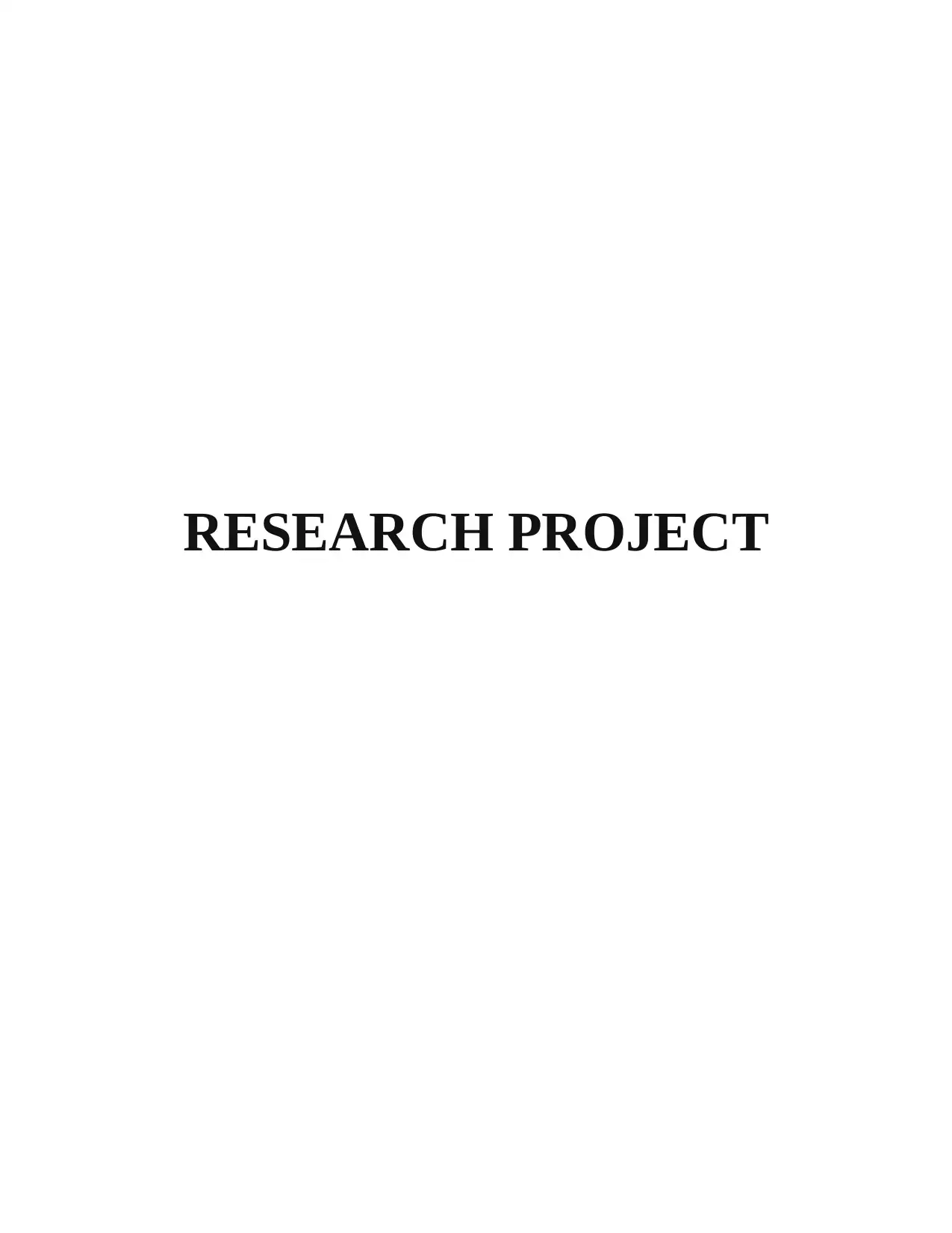
RESEARCH PROJECT
Paraphrase This Document
Need a fresh take? Get an instant paraphrase of this document with our AI Paraphraser
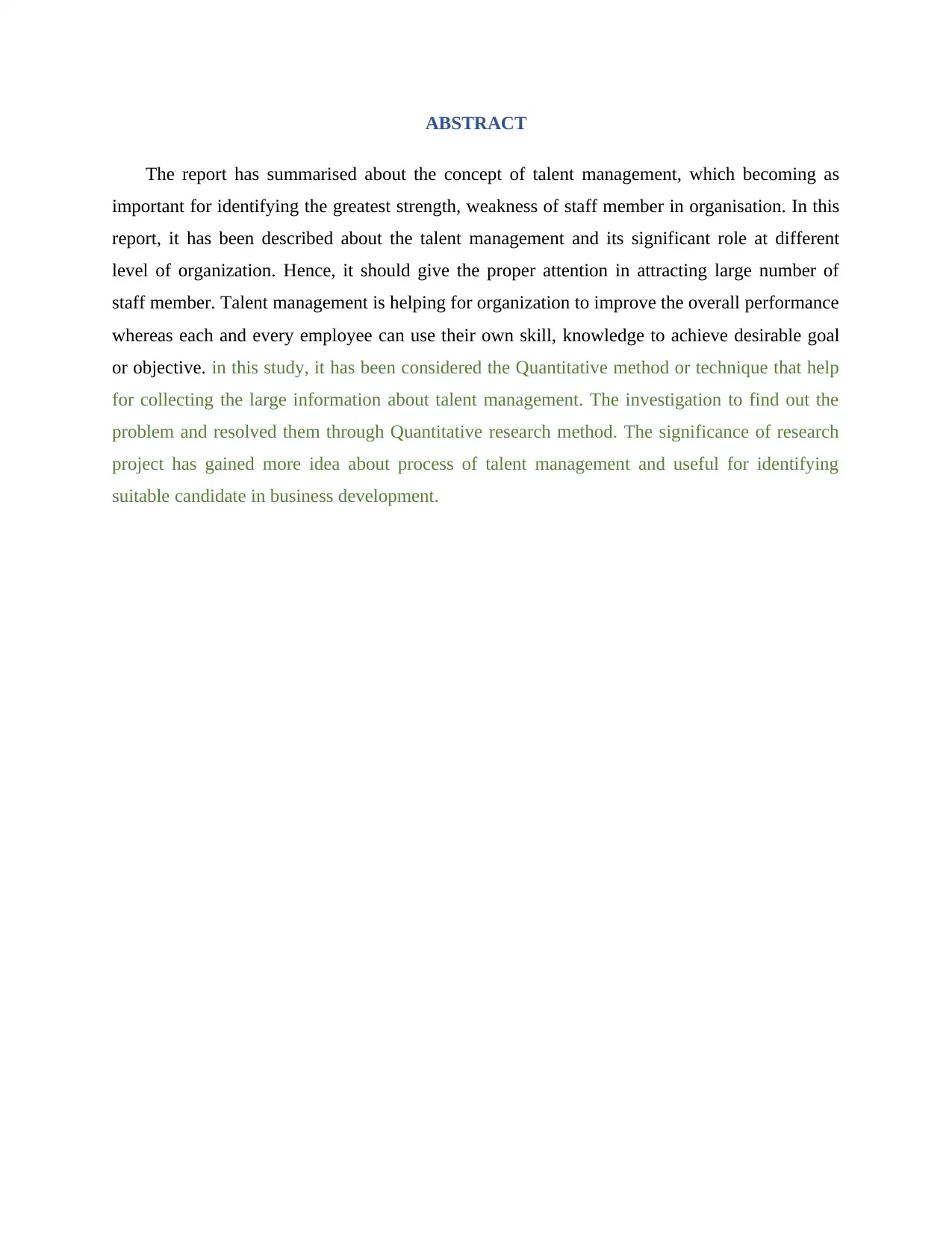
ABSTRACT
The report has summarised about the concept of talent management, which becoming as
important for identifying the greatest strength, weakness of staff member in organisation. In this
report, it has been described about the talent management and its significant role at different
level of organization. Hence, it should give the proper attention in attracting large number of
staff member. Talent management is helping for organization to improve the overall performance
whereas each and every employee can use their own skill, knowledge to achieve desirable goal
or objective. in this study, it has been considered the Quantitative method or technique that help
for collecting the large information about talent management. The investigation to find out the
problem and resolved them through Quantitative research method. The significance of research
project has gained more idea about process of talent management and useful for identifying
suitable candidate in business development.
The report has summarised about the concept of talent management, which becoming as
important for identifying the greatest strength, weakness of staff member in organisation. In this
report, it has been described about the talent management and its significant role at different
level of organization. Hence, it should give the proper attention in attracting large number of
staff member. Talent management is helping for organization to improve the overall performance
whereas each and every employee can use their own skill, knowledge to achieve desirable goal
or objective. in this study, it has been considered the Quantitative method or technique that help
for collecting the large information about talent management. The investigation to find out the
problem and resolved them through Quantitative research method. The significance of research
project has gained more idea about process of talent management and useful for identifying
suitable candidate in business development.
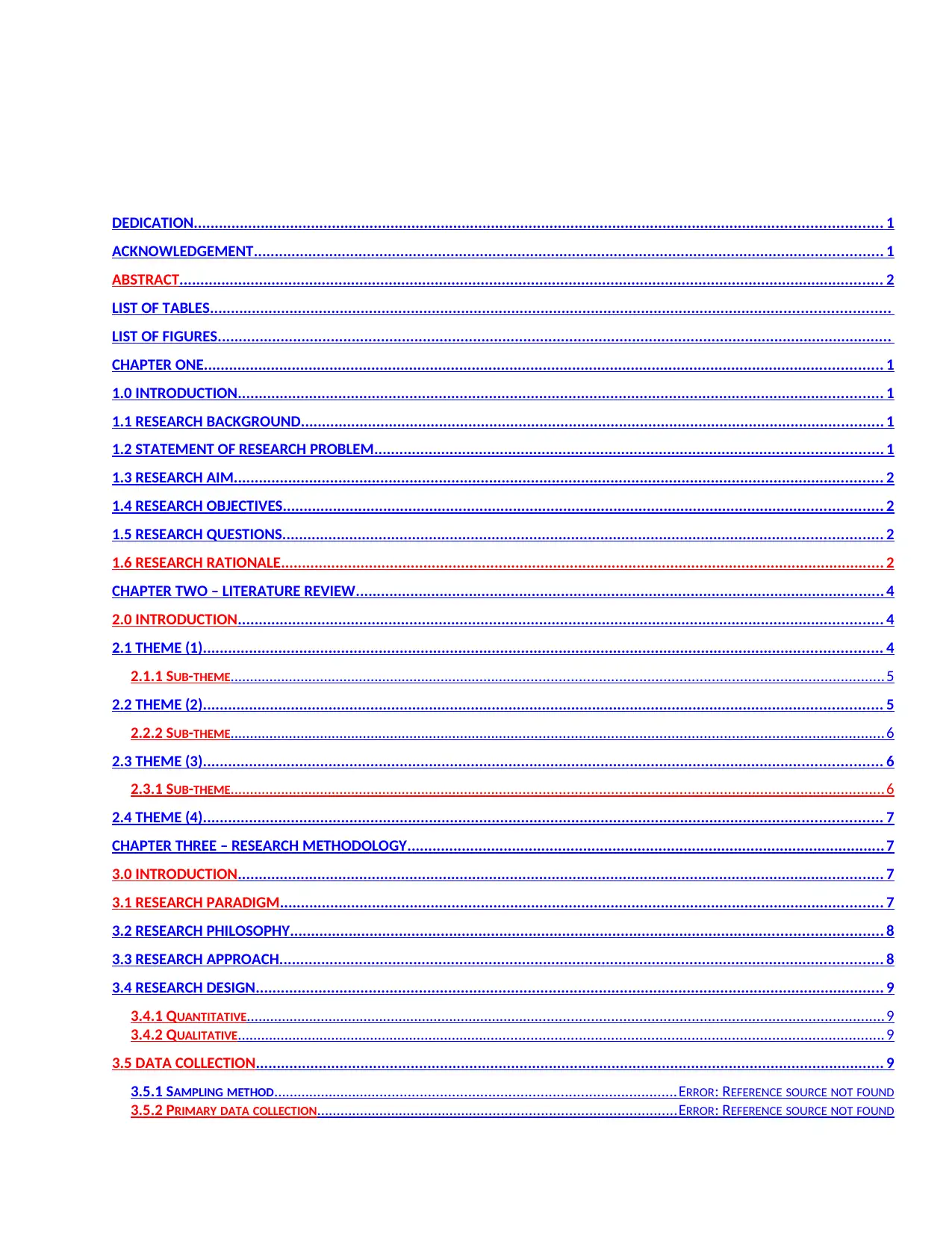
DEDICATION.................................................................................................................................................................... 1
ACKNOWLEDGEMENT...................................................................................................................................................... 1
ABSTRACT........................................................................................................................................................................ 2
LIST OF TABLES..................................................................................................................................................................
LIST OF FIGURES.................................................................................................................................................................
CHAPTER ONE.................................................................................................................................................................. 1
1.0 INTRODUCTION.......................................................................................................................................................... 1
1.1 RESEARCH BACKGROUND........................................................................................................................................... 1
1.2 STATEMENT OF RESEARCH PROBLEM......................................................................................................................... 1
1.3 RESEARCH AIM........................................................................................................................................................... 2
1.4 RESEARCH OBJECTIVES............................................................................................................................................... 2
1.5 RESEARCH QUESTIONS............................................................................................................................................... 2
1.6 RESEARCH RATIONALE................................................................................................................................................ 2
CHAPTER TWO – LITERATURE REVIEW.............................................................................................................................. 4
2.0 INTRODUCTION.......................................................................................................................................................... 4
2.1 THEME (1).................................................................................................................................................................. 4
2.1.1 SUB-THEME.....................................................................................................................................................................5
2.2 THEME (2).................................................................................................................................................................. 5
2.2.2 SUB-THEME.....................................................................................................................................................................6
2.3 THEME (3).................................................................................................................................................................. 6
2.3.1 SUB-THEME.....................................................................................................................................................................6
2.4 THEME (4).................................................................................................................................................................. 7
CHAPTER THREE – RESEARCH METHODOLOGY.................................................................................................................. 7
3.0 INTRODUCTION.......................................................................................................................................................... 7
3.1 RESEARCH PARADIGM................................................................................................................................................ 7
3.2 RESEARCH PHILOSOPHY............................................................................................................................................. 8
3.3 RESEARCH APPROACH................................................................................................................................................ 8
3.4 RESEARCH DESIGN...................................................................................................................................................... 9
3.4.1 QUANTITATIVE.................................................................................................................................................................9
3.4.2 QUALITATIVE................................................................................................................................................................... 9
3.5 DATA COLLECTION...................................................................................................................................................... 9
3.5.1 SAMPLING METHOD.....................................................................................................ERROR: REFERENCE SOURCE NOT FOUND
3.5.2 PRIMARY DATA COLLECTION...........................................................................................ERROR: REFERENCE SOURCE NOT FOUND
ACKNOWLEDGEMENT...................................................................................................................................................... 1
ABSTRACT........................................................................................................................................................................ 2
LIST OF TABLES..................................................................................................................................................................
LIST OF FIGURES.................................................................................................................................................................
CHAPTER ONE.................................................................................................................................................................. 1
1.0 INTRODUCTION.......................................................................................................................................................... 1
1.1 RESEARCH BACKGROUND........................................................................................................................................... 1
1.2 STATEMENT OF RESEARCH PROBLEM......................................................................................................................... 1
1.3 RESEARCH AIM........................................................................................................................................................... 2
1.4 RESEARCH OBJECTIVES............................................................................................................................................... 2
1.5 RESEARCH QUESTIONS............................................................................................................................................... 2
1.6 RESEARCH RATIONALE................................................................................................................................................ 2
CHAPTER TWO – LITERATURE REVIEW.............................................................................................................................. 4
2.0 INTRODUCTION.......................................................................................................................................................... 4
2.1 THEME (1).................................................................................................................................................................. 4
2.1.1 SUB-THEME.....................................................................................................................................................................5
2.2 THEME (2).................................................................................................................................................................. 5
2.2.2 SUB-THEME.....................................................................................................................................................................6
2.3 THEME (3).................................................................................................................................................................. 6
2.3.1 SUB-THEME.....................................................................................................................................................................6
2.4 THEME (4).................................................................................................................................................................. 7
CHAPTER THREE – RESEARCH METHODOLOGY.................................................................................................................. 7
3.0 INTRODUCTION.......................................................................................................................................................... 7
3.1 RESEARCH PARADIGM................................................................................................................................................ 7
3.2 RESEARCH PHILOSOPHY............................................................................................................................................. 8
3.3 RESEARCH APPROACH................................................................................................................................................ 8
3.4 RESEARCH DESIGN...................................................................................................................................................... 9
3.4.1 QUANTITATIVE.................................................................................................................................................................9
3.4.2 QUALITATIVE................................................................................................................................................................... 9
3.5 DATA COLLECTION...................................................................................................................................................... 9
3.5.1 SAMPLING METHOD.....................................................................................................ERROR: REFERENCE SOURCE NOT FOUND
3.5.2 PRIMARY DATA COLLECTION...........................................................................................ERROR: REFERENCE SOURCE NOT FOUND
⊘ This is a preview!⊘
Do you want full access?
Subscribe today to unlock all pages.

Trusted by 1+ million students worldwide
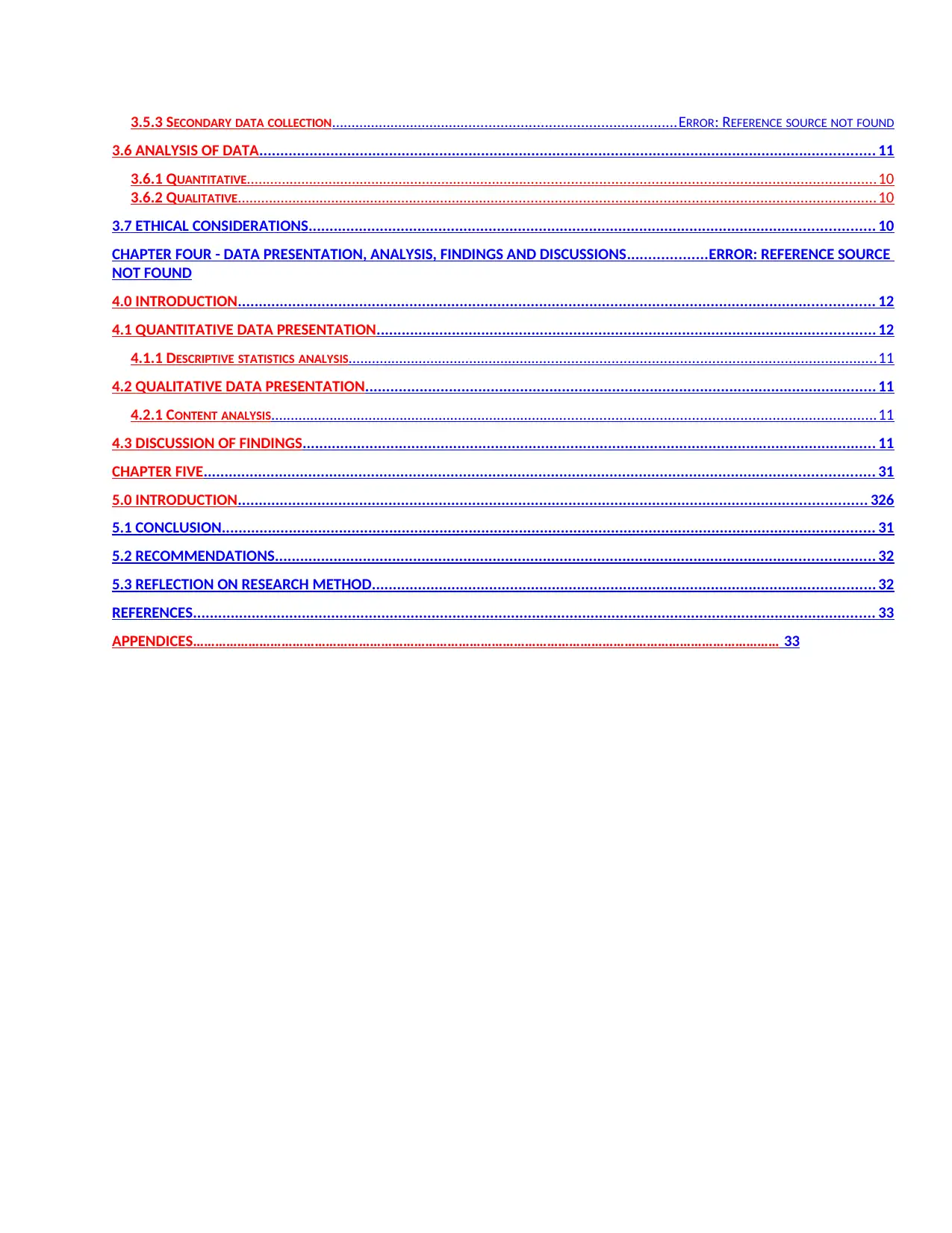
3.5.3 SECONDARY DATA COLLECTION.......................................................................................ERROR: REFERENCE SOURCE NOT FOUND
3.6 ANALYSIS OF DATA................................................................................................................................................... 11
3.6.1 QUANTITATIVE...............................................................................................................................................................10
3.6.2 QUALITATIVE.................................................................................................................................................................10
3.7 ETHICAL CONSIDERATIONS....................................................................................................................................... 10
CHAPTER FOUR - DATA PRESENTATION, ANALYSIS, FINDINGS AND DISCUSSIONS...................ERROR: REFERENCE SOURCE
NOT FOUND
4.0 INTRODUCTION........................................................................................................................................................ 12
4.1 QUANTITATIVE DATA PRESENTATION....................................................................................................................... 12
4.1.1 DESCRIPTIVE STATISTICS ANALYSIS.....................................................................................................................................11
4.2 QUALITATIVE DATA PRESENTATION.......................................................................................................................... 11
4.2.1 CONTENT ANALYSIS.........................................................................................................................................................11
4.3 DISCUSSION OF FINDINGS......................................................................................................................................... 11
CHAPTER FIVE................................................................................................................................................................ 31
5.0 INTRODUCTION...................................................................................................................................................... 326
5.1 CONCLUSION............................................................................................................................................................ 31
5.2 RECOMMENDATIONS............................................................................................................................................... 32
5.3 REFLECTION ON RESEARCH METHOD........................................................................................................................ 32
REFERENCES................................................................................................................................................................... 33
APPENDICES…………………………………………………………………………………………………………………………………………… 33
3.6 ANALYSIS OF DATA................................................................................................................................................... 11
3.6.1 QUANTITATIVE...............................................................................................................................................................10
3.6.2 QUALITATIVE.................................................................................................................................................................10
3.7 ETHICAL CONSIDERATIONS....................................................................................................................................... 10
CHAPTER FOUR - DATA PRESENTATION, ANALYSIS, FINDINGS AND DISCUSSIONS...................ERROR: REFERENCE SOURCE
NOT FOUND
4.0 INTRODUCTION........................................................................................................................................................ 12
4.1 QUANTITATIVE DATA PRESENTATION....................................................................................................................... 12
4.1.1 DESCRIPTIVE STATISTICS ANALYSIS.....................................................................................................................................11
4.2 QUALITATIVE DATA PRESENTATION.......................................................................................................................... 11
4.2.1 CONTENT ANALYSIS.........................................................................................................................................................11
4.3 DISCUSSION OF FINDINGS......................................................................................................................................... 11
CHAPTER FIVE................................................................................................................................................................ 31
5.0 INTRODUCTION...................................................................................................................................................... 326
5.1 CONCLUSION............................................................................................................................................................ 31
5.2 RECOMMENDATIONS............................................................................................................................................... 32
5.3 REFLECTION ON RESEARCH METHOD........................................................................................................................ 32
REFERENCES................................................................................................................................................................... 33
APPENDICES…………………………………………………………………………………………………………………………………………… 33
Paraphrase This Document
Need a fresh take? Get an instant paraphrase of this document with our AI Paraphraser
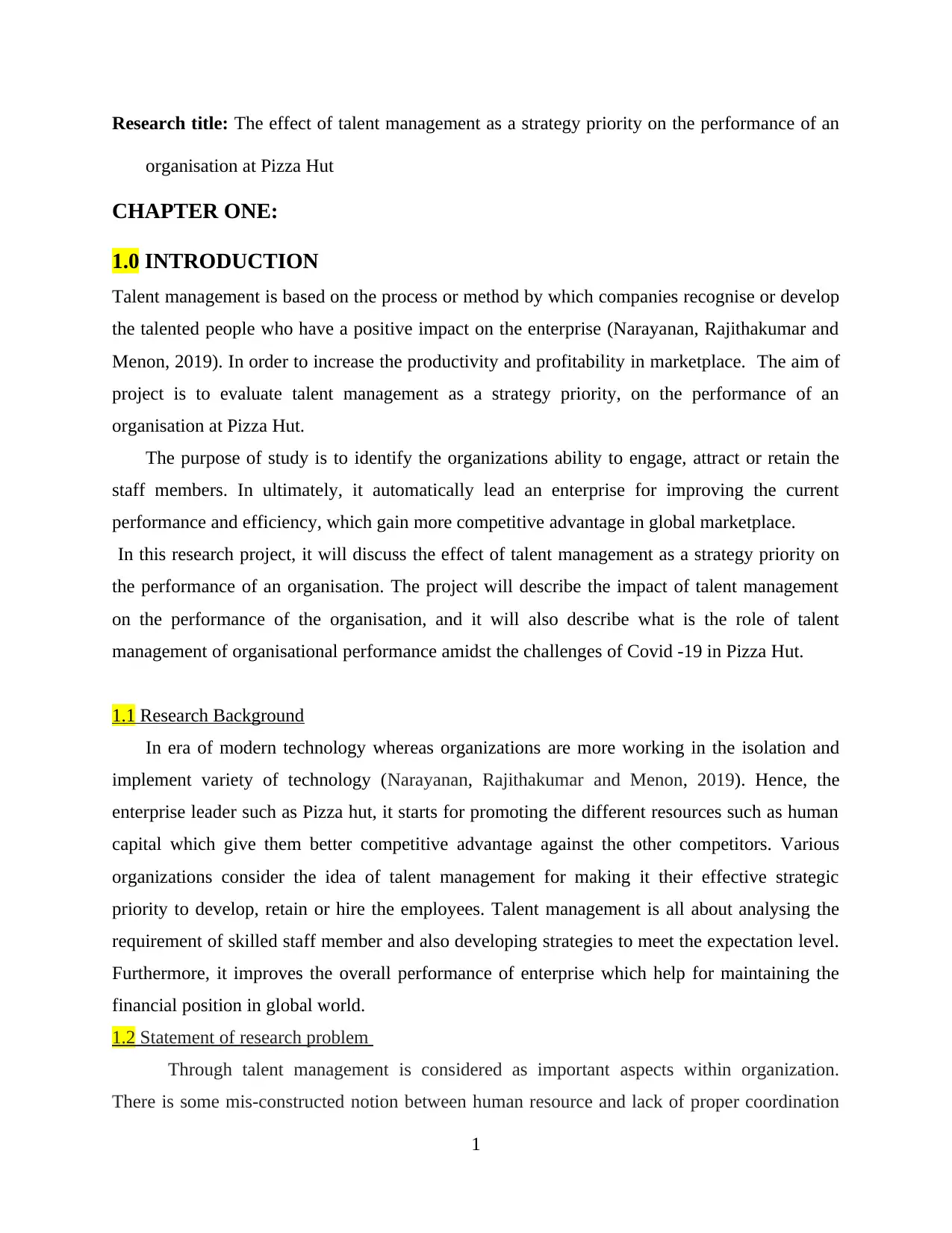
Research title: The effect of talent management as a strategy priority on the performance of an
organisation at Pizza Hut
CHAPTER ONE:
1.0 INTRODUCTION
Talent management is based on the process or method by which companies recognise or develop
the talented people who have a positive impact on the enterprise (Narayanan, Rajithakumar and
Menon, 2019). In order to increase the productivity and profitability in marketplace. The aim of
project is to evaluate talent management as a strategy priority, on the performance of an
organisation at Pizza Hut.
The purpose of study is to identify the organizations ability to engage, attract or retain the
staff members. In ultimately, it automatically lead an enterprise for improving the current
performance and efficiency, which gain more competitive advantage in global marketplace.
In this research project, it will discuss the effect of talent management as a strategy priority on
the performance of an organisation. The project will describe the impact of talent management
on the performance of the organisation, and it will also describe what is the role of talent
management of organisational performance amidst the challenges of Covid -19 in Pizza Hut.
1.1 Research Background
In era of modern technology whereas organizations are more working in the isolation and
implement variety of technology (Narayanan, Rajithakumar and Menon, 2019). Hence, the
enterprise leader such as Pizza hut, it starts for promoting the different resources such as human
capital which give them better competitive advantage against the other competitors. Various
organizations consider the idea of talent management for making it their effective strategic
priority to develop, retain or hire the employees. Talent management is all about analysing the
requirement of skilled staff member and also developing strategies to meet the expectation level.
Furthermore, it improves the overall performance of enterprise which help for maintaining the
financial position in global world.
1.2 Statement of research problem
Through talent management is considered as important aspects within organization.
There is some mis-constructed notion between human resource and lack of proper coordination
1
organisation at Pizza Hut
CHAPTER ONE:
1.0 INTRODUCTION
Talent management is based on the process or method by which companies recognise or develop
the talented people who have a positive impact on the enterprise (Narayanan, Rajithakumar and
Menon, 2019). In order to increase the productivity and profitability in marketplace. The aim of
project is to evaluate talent management as a strategy priority, on the performance of an
organisation at Pizza Hut.
The purpose of study is to identify the organizations ability to engage, attract or retain the
staff members. In ultimately, it automatically lead an enterprise for improving the current
performance and efficiency, which gain more competitive advantage in global marketplace.
In this research project, it will discuss the effect of talent management as a strategy priority on
the performance of an organisation. The project will describe the impact of talent management
on the performance of the organisation, and it will also describe what is the role of talent
management of organisational performance amidst the challenges of Covid -19 in Pizza Hut.
1.1 Research Background
In era of modern technology whereas organizations are more working in the isolation and
implement variety of technology (Narayanan, Rajithakumar and Menon, 2019). Hence, the
enterprise leader such as Pizza hut, it starts for promoting the different resources such as human
capital which give them better competitive advantage against the other competitors. Various
organizations consider the idea of talent management for making it their effective strategic
priority to develop, retain or hire the employees. Talent management is all about analysing the
requirement of skilled staff member and also developing strategies to meet the expectation level.
Furthermore, it improves the overall performance of enterprise which help for maintaining the
financial position in global world.
1.2 Statement of research problem
Through talent management is considered as important aspects within organization.
There is some mis-constructed notion between human resource and lack of proper coordination
1
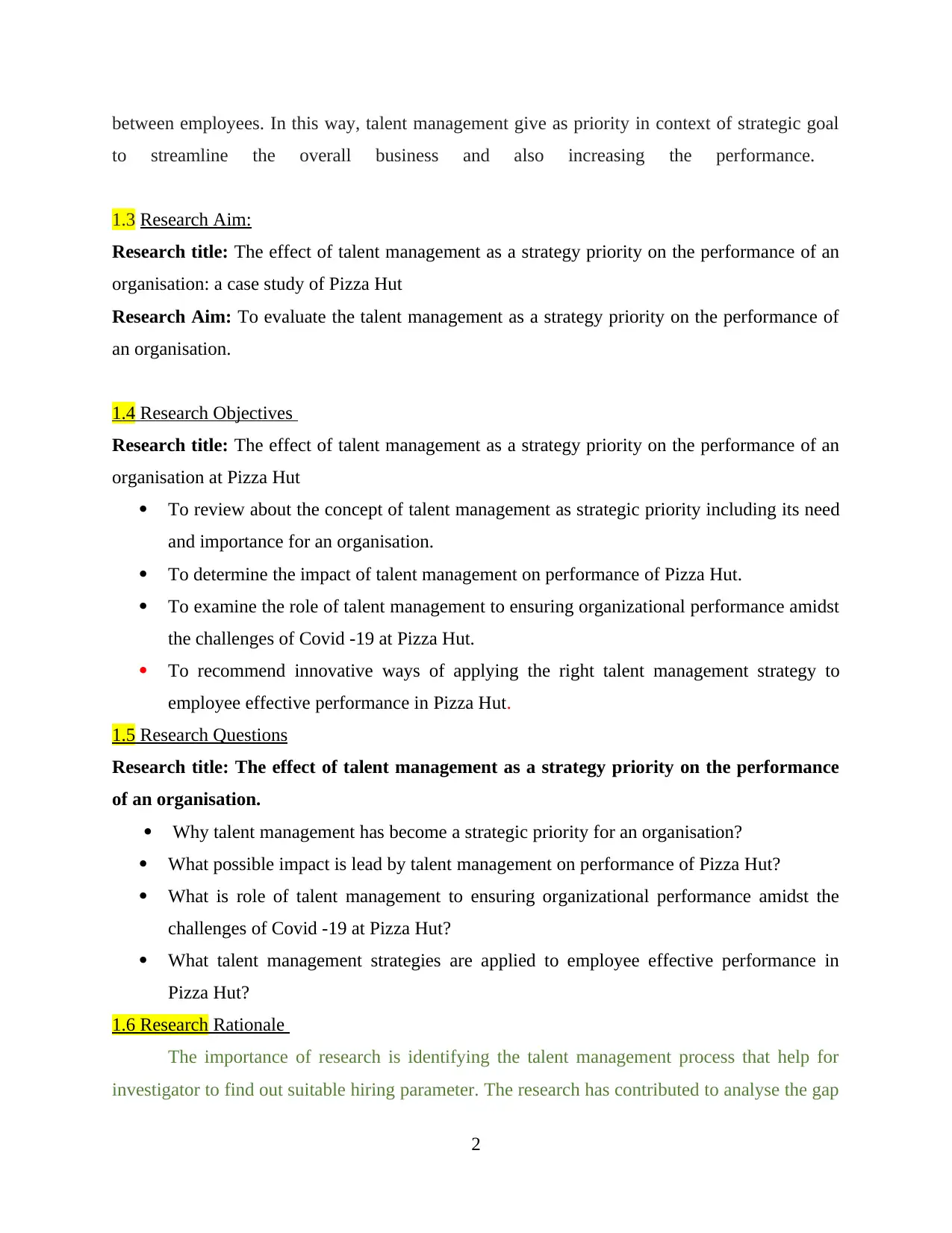
between employees. In this way, talent management give as priority in context of strategic goal
to streamline the overall business and also increasing the performance.
1.3 Research Aim:
Research title: The effect of talent management as a strategy priority on the performance of an
organisation: a case study of Pizza Hut
Research Aim: To evaluate the talent management as a strategy priority on the performance of
an organisation.
1.4 Research Objectives
Research title: The effect of talent management as a strategy priority on the performance of an
organisation at Pizza Hut
To review about the concept of talent management as strategic priority including its need
and importance for an organisation.
To determine the impact of talent management on performance of Pizza Hut.
To examine the role of talent management to ensuring organizational performance amidst
the challenges of Covid -19 at Pizza Hut.
To recommend innovative ways of applying the right talent management strategy to
employee effective performance in Pizza Hut.
1.5 Research Questions
Research title: The effect of talent management as a strategy priority on the performance
of an organisation.
Why talent management has become a strategic priority for an organisation?
What possible impact is lead by talent management on performance of Pizza Hut?
What is role of talent management to ensuring organizational performance amidst the
challenges of Covid -19 at Pizza Hut?
What talent management strategies are applied to employee effective performance in
Pizza Hut?
1.6 Research Rationale
The importance of research is identifying the talent management process that help for
investigator to find out suitable hiring parameter. The research has contributed to analyse the gap
2
to streamline the overall business and also increasing the performance.
1.3 Research Aim:
Research title: The effect of talent management as a strategy priority on the performance of an
organisation: a case study of Pizza Hut
Research Aim: To evaluate the talent management as a strategy priority on the performance of
an organisation.
1.4 Research Objectives
Research title: The effect of talent management as a strategy priority on the performance of an
organisation at Pizza Hut
To review about the concept of talent management as strategic priority including its need
and importance for an organisation.
To determine the impact of talent management on performance of Pizza Hut.
To examine the role of talent management to ensuring organizational performance amidst
the challenges of Covid -19 at Pizza Hut.
To recommend innovative ways of applying the right talent management strategy to
employee effective performance in Pizza Hut.
1.5 Research Questions
Research title: The effect of talent management as a strategy priority on the performance
of an organisation.
Why talent management has become a strategic priority for an organisation?
What possible impact is lead by talent management on performance of Pizza Hut?
What is role of talent management to ensuring organizational performance amidst the
challenges of Covid -19 at Pizza Hut?
What talent management strategies are applied to employee effective performance in
Pizza Hut?
1.6 Research Rationale
The importance of research is identifying the talent management process that help for
investigator to find out suitable hiring parameter. The research has contributed to analyse the gap
2
⊘ This is a preview!⊘
Do you want full access?
Subscribe today to unlock all pages.

Trusted by 1+ million students worldwide
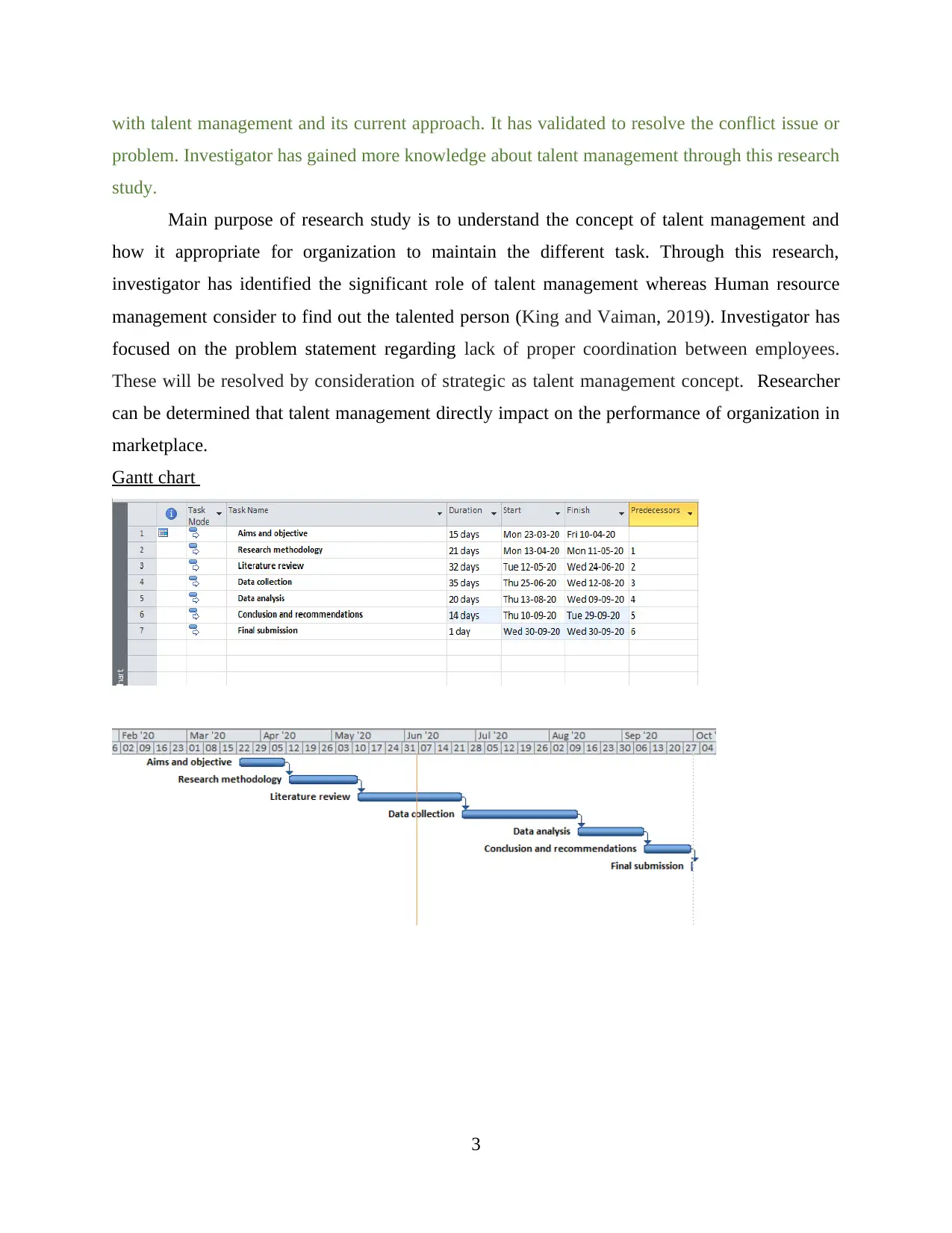
with talent management and its current approach. It has validated to resolve the conflict issue or
problem. Investigator has gained more knowledge about talent management through this research
study.
Main purpose of research study is to understand the concept of talent management and
how it appropriate for organization to maintain the different task. Through this research,
investigator has identified the significant role of talent management whereas Human resource
management consider to find out the talented person (King and Vaiman, 2019). Investigator has
focused on the problem statement regarding lack of proper coordination between employees.
These will be resolved by consideration of strategic as talent management concept. Researcher
can be determined that talent management directly impact on the performance of organization in
marketplace.
Gantt chart
3
problem. Investigator has gained more knowledge about talent management through this research
study.
Main purpose of research study is to understand the concept of talent management and
how it appropriate for organization to maintain the different task. Through this research,
investigator has identified the significant role of talent management whereas Human resource
management consider to find out the talented person (King and Vaiman, 2019). Investigator has
focused on the problem statement regarding lack of proper coordination between employees.
These will be resolved by consideration of strategic as talent management concept. Researcher
can be determined that talent management directly impact on the performance of organization in
marketplace.
Gantt chart
3
Paraphrase This Document
Need a fresh take? Get an instant paraphrase of this document with our AI Paraphraser
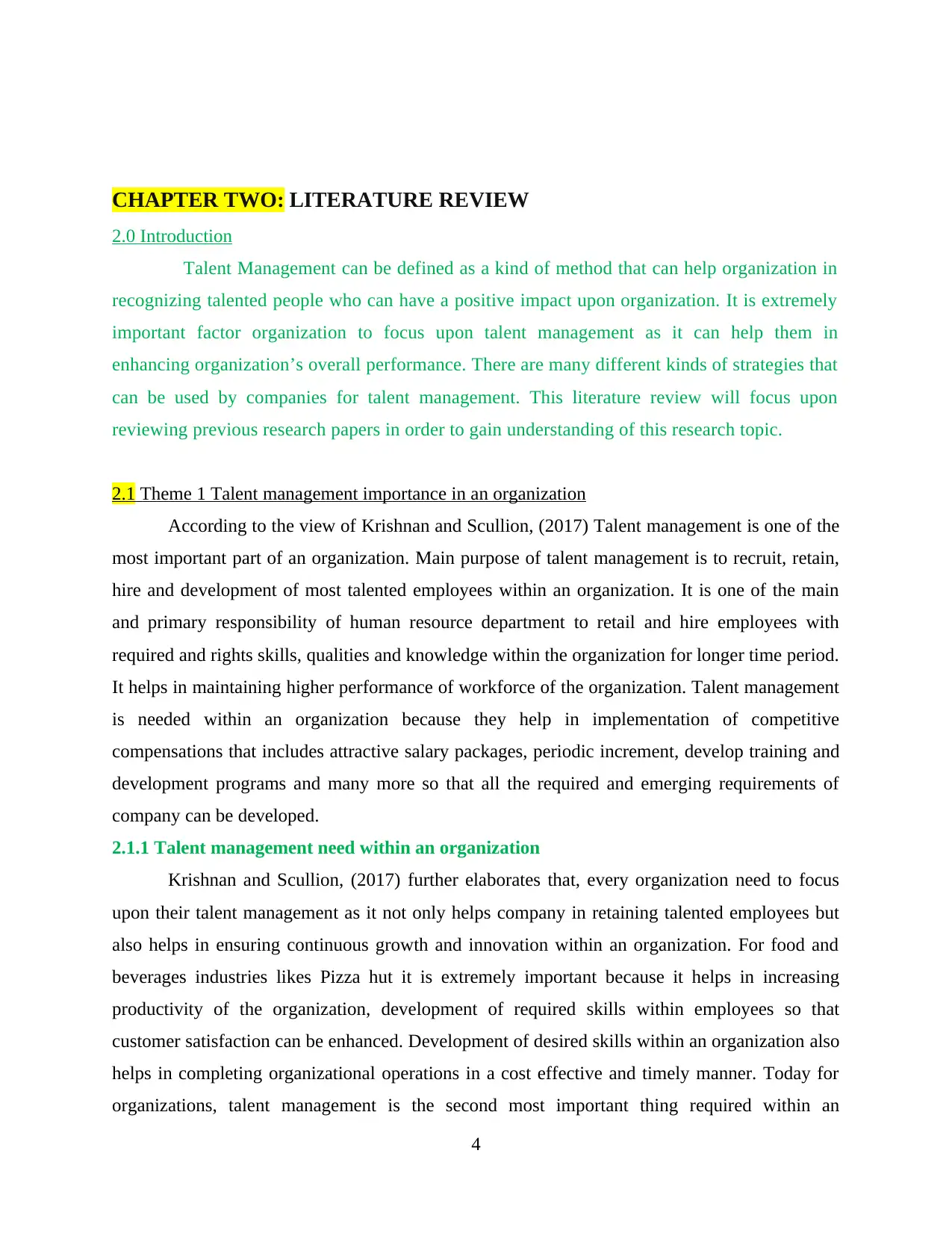
CHAPTER TWO: LITERATURE REVIEW
2.0 Introduction
Talent Management can be defined as a kind of method that can help organization in
recognizing talented people who can have a positive impact upon organization. It is extremely
important factor organization to focus upon talent management as it can help them in
enhancing organization’s overall performance. There are many different kinds of strategies that
can be used by companies for talent management. This literature review will focus upon
reviewing previous research papers in order to gain understanding of this research topic.
2.1 Theme 1 Talent management importance in an organization
According to the view of Krishnan and Scullion, (2017) Talent management is one of the
most important part of an organization. Main purpose of talent management is to recruit, retain,
hire and development of most talented employees within an organization. It is one of the main
and primary responsibility of human resource department to retail and hire employees with
required and rights skills, qualities and knowledge within the organization for longer time period.
It helps in maintaining higher performance of workforce of the organization. Talent management
is needed within an organization because they help in implementation of competitive
compensations that includes attractive salary packages, periodic increment, develop training and
development programs and many more so that all the required and emerging requirements of
company can be developed.
2.1.1 Talent management need within an organization
Krishnan and Scullion, (2017) further elaborates that, every organization need to focus
upon their talent management as it not only helps company in retaining talented employees but
also helps in ensuring continuous growth and innovation within an organization. For food and
beverages industries likes Pizza hut it is extremely important because it helps in increasing
productivity of the organization, development of required skills within employees so that
customer satisfaction can be enhanced. Development of desired skills within an organization also
helps in completing organizational operations in a cost effective and timely manner. Today for
organizations, talent management is the second most important thing required within an
4
2.0 Introduction
Talent Management can be defined as a kind of method that can help organization in
recognizing talented people who can have a positive impact upon organization. It is extremely
important factor organization to focus upon talent management as it can help them in
enhancing organization’s overall performance. There are many different kinds of strategies that
can be used by companies for talent management. This literature review will focus upon
reviewing previous research papers in order to gain understanding of this research topic.
2.1 Theme 1 Talent management importance in an organization
According to the view of Krishnan and Scullion, (2017) Talent management is one of the
most important part of an organization. Main purpose of talent management is to recruit, retain,
hire and development of most talented employees within an organization. It is one of the main
and primary responsibility of human resource department to retail and hire employees with
required and rights skills, qualities and knowledge within the organization for longer time period.
It helps in maintaining higher performance of workforce of the organization. Talent management
is needed within an organization because they help in implementation of competitive
compensations that includes attractive salary packages, periodic increment, develop training and
development programs and many more so that all the required and emerging requirements of
company can be developed.
2.1.1 Talent management need within an organization
Krishnan and Scullion, (2017) further elaborates that, every organization need to focus
upon their talent management as it not only helps company in retaining talented employees but
also helps in ensuring continuous growth and innovation within an organization. For food and
beverages industries likes Pizza hut it is extremely important because it helps in increasing
productivity of the organization, development of required skills within employees so that
customer satisfaction can be enhanced. Development of desired skills within an organization also
helps in completing organizational operations in a cost effective and timely manner. Today for
organizations, talent management is the second most important thing required within an
4
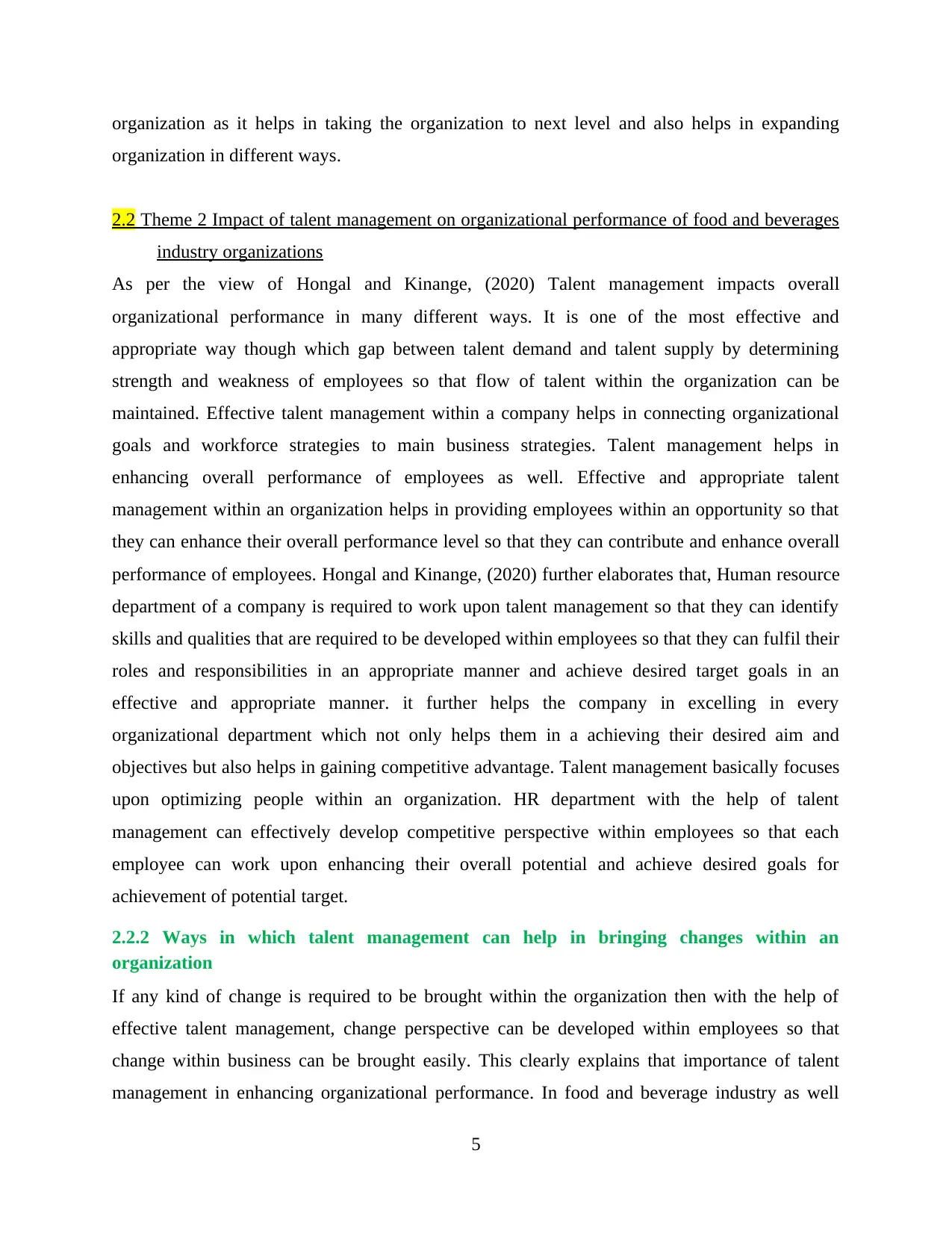
organization as it helps in taking the organization to next level and also helps in expanding
organization in different ways.
2.2 Theme 2 Impact of talent management on organizational performance of food and beverages
industry organizations
As per the view of Hongal and Kinange, (2020) Talent management impacts overall
organizational performance in many different ways. It is one of the most effective and
appropriate way though which gap between talent demand and talent supply by determining
strength and weakness of employees so that flow of talent within the organization can be
maintained. Effective talent management within a company helps in connecting organizational
goals and workforce strategies to main business strategies. Talent management helps in
enhancing overall performance of employees as well. Effective and appropriate talent
management within an organization helps in providing employees within an opportunity so that
they can enhance their overall performance level so that they can contribute and enhance overall
performance of employees. Hongal and Kinange, (2020) further elaborates that, Human resource
department of a company is required to work upon talent management so that they can identify
skills and qualities that are required to be developed within employees so that they can fulfil their
roles and responsibilities in an appropriate manner and achieve desired target goals in an
effective and appropriate manner. it further helps the company in excelling in every
organizational department which not only helps them in a achieving their desired aim and
objectives but also helps in gaining competitive advantage. Talent management basically focuses
upon optimizing people within an organization. HR department with the help of talent
management can effectively develop competitive perspective within employees so that each
employee can work upon enhancing their overall potential and achieve desired goals for
achievement of potential target.
2.2.2 Ways in which talent management can help in bringing changes within an
organization
If any kind of change is required to be brought within the organization then with the help of
effective talent management, change perspective can be developed within employees so that
change within business can be brought easily. This clearly explains that importance of talent
management in enhancing organizational performance. In food and beverage industry as well
5
organization in different ways.
2.2 Theme 2 Impact of talent management on organizational performance of food and beverages
industry organizations
As per the view of Hongal and Kinange, (2020) Talent management impacts overall
organizational performance in many different ways. It is one of the most effective and
appropriate way though which gap between talent demand and talent supply by determining
strength and weakness of employees so that flow of talent within the organization can be
maintained. Effective talent management within a company helps in connecting organizational
goals and workforce strategies to main business strategies. Talent management helps in
enhancing overall performance of employees as well. Effective and appropriate talent
management within an organization helps in providing employees within an opportunity so that
they can enhance their overall performance level so that they can contribute and enhance overall
performance of employees. Hongal and Kinange, (2020) further elaborates that, Human resource
department of a company is required to work upon talent management so that they can identify
skills and qualities that are required to be developed within employees so that they can fulfil their
roles and responsibilities in an appropriate manner and achieve desired target goals in an
effective and appropriate manner. it further helps the company in excelling in every
organizational department which not only helps them in a achieving their desired aim and
objectives but also helps in gaining competitive advantage. Talent management basically focuses
upon optimizing people within an organization. HR department with the help of talent
management can effectively develop competitive perspective within employees so that each
employee can work upon enhancing their overall potential and achieve desired goals for
achievement of potential target.
2.2.2 Ways in which talent management can help in bringing changes within an
organization
If any kind of change is required to be brought within the organization then with the help of
effective talent management, change perspective can be developed within employees so that
change within business can be brought easily. This clearly explains that importance of talent
management in enhancing organizational performance. In food and beverage industry as well
5
⊘ This is a preview!⊘
Do you want full access?
Subscribe today to unlock all pages.

Trusted by 1+ million students worldwide
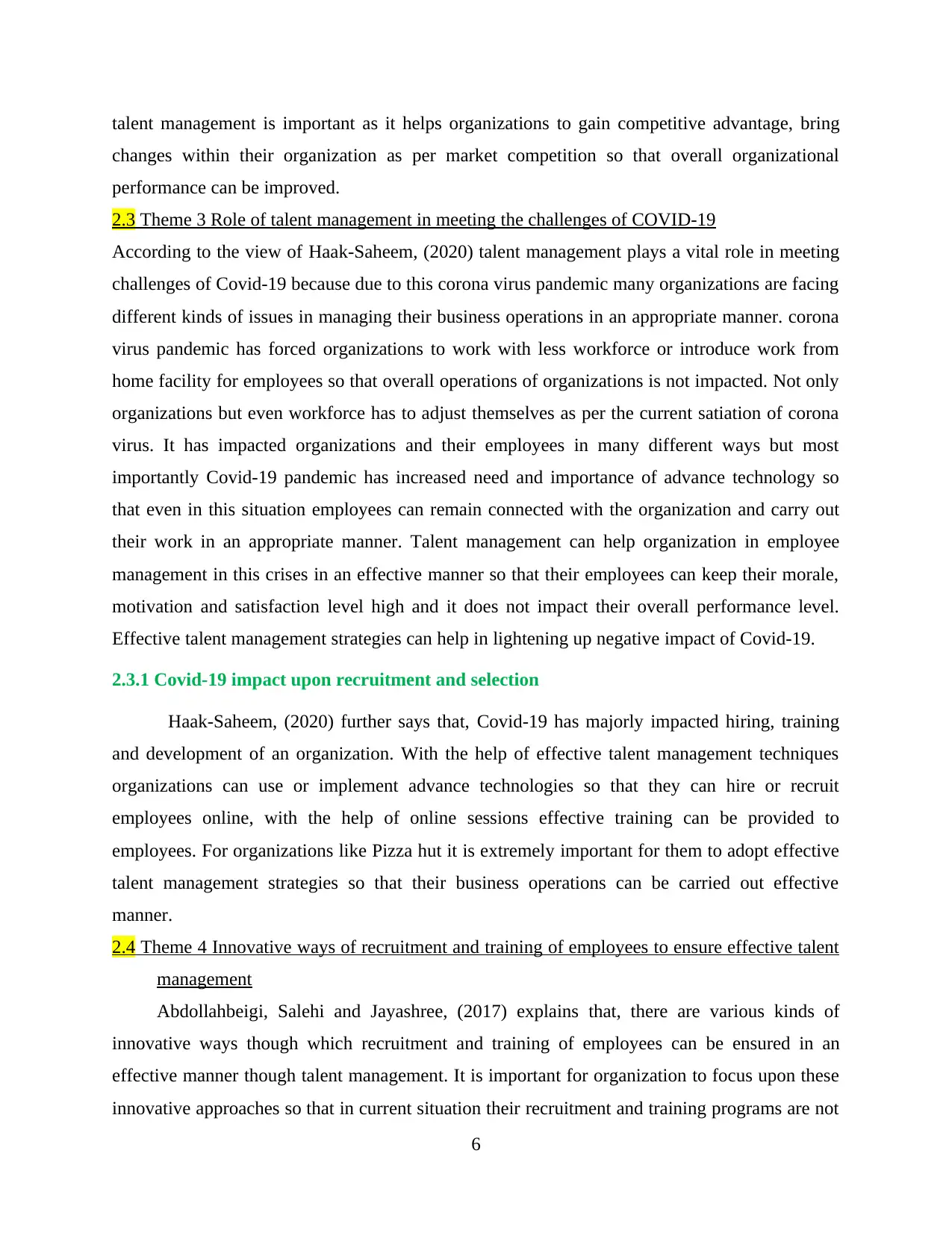
talent management is important as it helps organizations to gain competitive advantage, bring
changes within their organization as per market competition so that overall organizational
performance can be improved.
2.3 Theme 3 Role of talent management in meeting the challenges of COVID-19
According to the view of Haak-Saheem, (2020) talent management plays a vital role in meeting
challenges of Covid-19 because due to this corona virus pandemic many organizations are facing
different kinds of issues in managing their business operations in an appropriate manner. corona
virus pandemic has forced organizations to work with less workforce or introduce work from
home facility for employees so that overall operations of organizations is not impacted. Not only
organizations but even workforce has to adjust themselves as per the current satiation of corona
virus. It has impacted organizations and their employees in many different ways but most
importantly Covid-19 pandemic has increased need and importance of advance technology so
that even in this situation employees can remain connected with the organization and carry out
their work in an appropriate manner. Talent management can help organization in employee
management in this crises in an effective manner so that their employees can keep their morale,
motivation and satisfaction level high and it does not impact their overall performance level.
Effective talent management strategies can help in lightening up negative impact of Covid-19.
2.3.1 Covid-19 impact upon recruitment and selection
Haak-Saheem, (2020) further says that, Covid-19 has majorly impacted hiring, training
and development of an organization. With the help of effective talent management techniques
organizations can use or implement advance technologies so that they can hire or recruit
employees online, with the help of online sessions effective training can be provided to
employees. For organizations like Pizza hut it is extremely important for them to adopt effective
talent management strategies so that their business operations can be carried out effective
manner.
2.4 Theme 4 Innovative ways of recruitment and training of employees to ensure effective talent
management
Abdollahbeigi, Salehi and Jayashree, (2017) explains that, there are various kinds of
innovative ways though which recruitment and training of employees can be ensured in an
effective manner though talent management. It is important for organization to focus upon these
innovative approaches so that in current situation their recruitment and training programs are not
6
changes within their organization as per market competition so that overall organizational
performance can be improved.
2.3 Theme 3 Role of talent management in meeting the challenges of COVID-19
According to the view of Haak-Saheem, (2020) talent management plays a vital role in meeting
challenges of Covid-19 because due to this corona virus pandemic many organizations are facing
different kinds of issues in managing their business operations in an appropriate manner. corona
virus pandemic has forced organizations to work with less workforce or introduce work from
home facility for employees so that overall operations of organizations is not impacted. Not only
organizations but even workforce has to adjust themselves as per the current satiation of corona
virus. It has impacted organizations and their employees in many different ways but most
importantly Covid-19 pandemic has increased need and importance of advance technology so
that even in this situation employees can remain connected with the organization and carry out
their work in an appropriate manner. Talent management can help organization in employee
management in this crises in an effective manner so that their employees can keep their morale,
motivation and satisfaction level high and it does not impact their overall performance level.
Effective talent management strategies can help in lightening up negative impact of Covid-19.
2.3.1 Covid-19 impact upon recruitment and selection
Haak-Saheem, (2020) further says that, Covid-19 has majorly impacted hiring, training
and development of an organization. With the help of effective talent management techniques
organizations can use or implement advance technologies so that they can hire or recruit
employees online, with the help of online sessions effective training can be provided to
employees. For organizations like Pizza hut it is extremely important for them to adopt effective
talent management strategies so that their business operations can be carried out effective
manner.
2.4 Theme 4 Innovative ways of recruitment and training of employees to ensure effective talent
management
Abdollahbeigi, Salehi and Jayashree, (2017) explains that, there are various kinds of
innovative ways though which recruitment and training of employees can be ensured in an
effective manner though talent management. It is important for organization to focus upon these
innovative approaches so that in current situation their recruitment and training programs are not
6
Paraphrase This Document
Need a fresh take? Get an instant paraphrase of this document with our AI Paraphraser
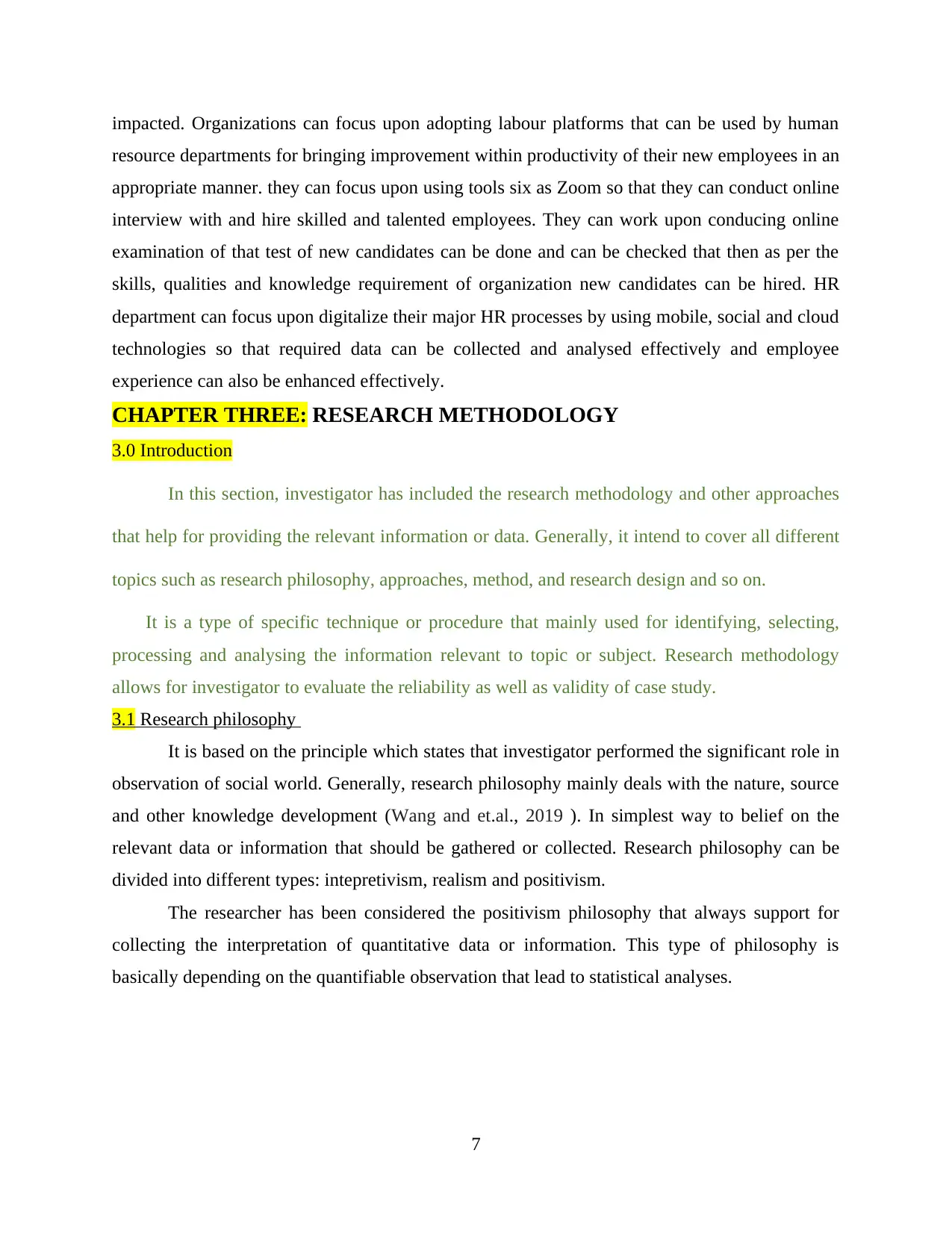
impacted. Organizations can focus upon adopting labour platforms that can be used by human
resource departments for bringing improvement within productivity of their new employees in an
appropriate manner. they can focus upon using tools six as Zoom so that they can conduct online
interview with and hire skilled and talented employees. They can work upon conducing online
examination of that test of new candidates can be done and can be checked that then as per the
skills, qualities and knowledge requirement of organization new candidates can be hired. HR
department can focus upon digitalize their major HR processes by using mobile, social and cloud
technologies so that required data can be collected and analysed effectively and employee
experience can also be enhanced effectively.
CHAPTER THREE: RESEARCH METHODOLOGY
3.0 Introduction
In this section, investigator has included the research methodology and other approaches
that help for providing the relevant information or data. Generally, it intend to cover all different
topics such as research philosophy, approaches, method, and research design and so on.
It is a type of specific technique or procedure that mainly used for identifying, selecting,
processing and analysing the information relevant to topic or subject. Research methodology
allows for investigator to evaluate the reliability as well as validity of case study.
3.1 Research philosophy
It is based on the principle which states that investigator performed the significant role in
observation of social world. Generally, research philosophy mainly deals with the nature, source
and other knowledge development (Wang and et.al., 2019 ). In simplest way to belief on the
relevant data or information that should be gathered or collected. Research philosophy can be
divided into different types: intepretivism, realism and positivism.
The researcher has been considered the positivism philosophy that always support for
collecting the interpretation of quantitative data or information. This type of philosophy is
basically depending on the quantifiable observation that lead to statistical analyses.
7
resource departments for bringing improvement within productivity of their new employees in an
appropriate manner. they can focus upon using tools six as Zoom so that they can conduct online
interview with and hire skilled and talented employees. They can work upon conducing online
examination of that test of new candidates can be done and can be checked that then as per the
skills, qualities and knowledge requirement of organization new candidates can be hired. HR
department can focus upon digitalize their major HR processes by using mobile, social and cloud
technologies so that required data can be collected and analysed effectively and employee
experience can also be enhanced effectively.
CHAPTER THREE: RESEARCH METHODOLOGY
3.0 Introduction
In this section, investigator has included the research methodology and other approaches
that help for providing the relevant information or data. Generally, it intend to cover all different
topics such as research philosophy, approaches, method, and research design and so on.
It is a type of specific technique or procedure that mainly used for identifying, selecting,
processing and analysing the information relevant to topic or subject. Research methodology
allows for investigator to evaluate the reliability as well as validity of case study.
3.1 Research philosophy
It is based on the principle which states that investigator performed the significant role in
observation of social world. Generally, research philosophy mainly deals with the nature, source
and other knowledge development (Wang and et.al., 2019 ). In simplest way to belief on the
relevant data or information that should be gathered or collected. Research philosophy can be
divided into different types: intepretivism, realism and positivism.
The researcher has been considered the positivism philosophy that always support for
collecting the interpretation of quantitative data or information. This type of philosophy is
basically depending on the quantifiable observation that lead to statistical analyses.
7
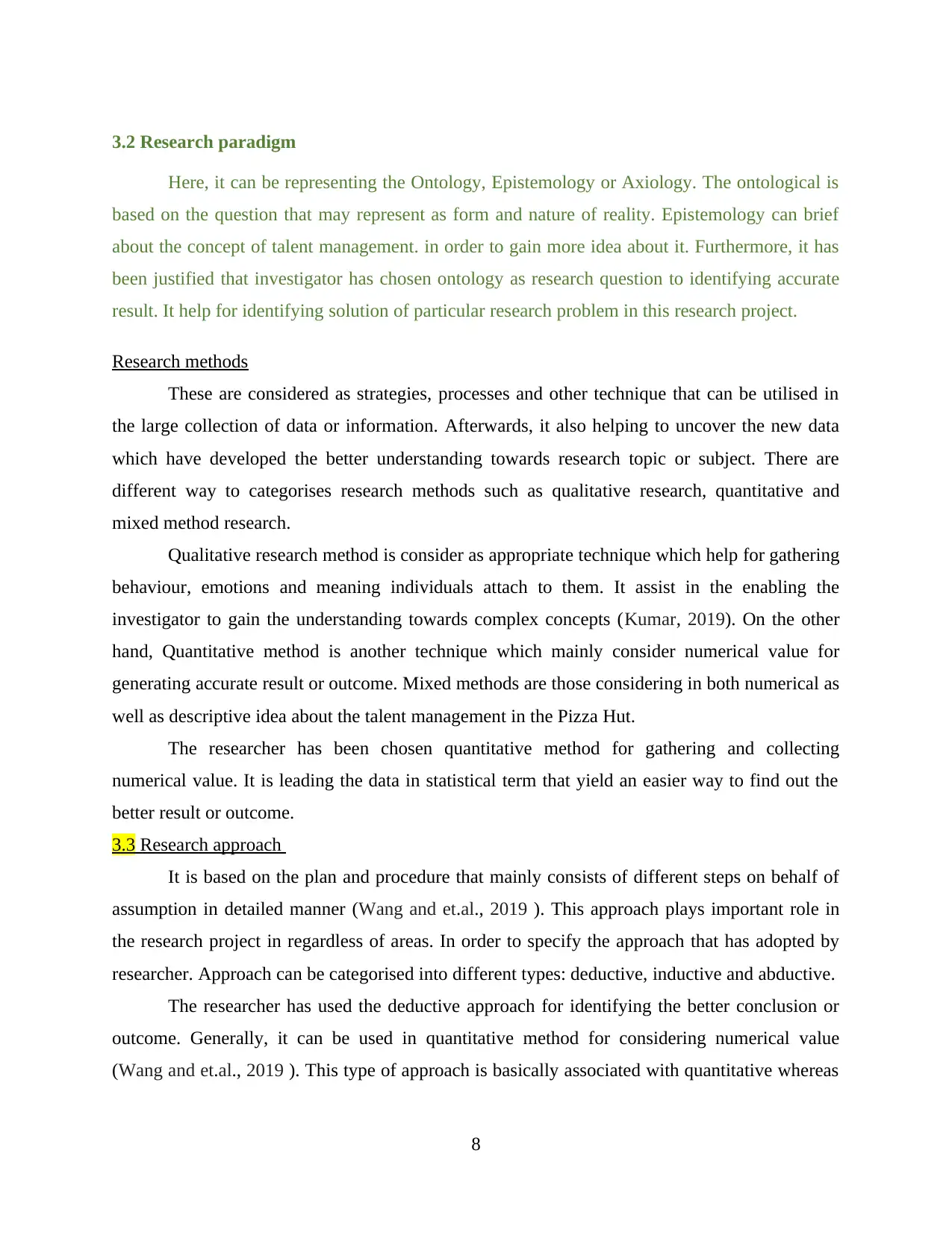
3.2 Research paradigm
Here, it can be representing the Ontology, Epistemology or Axiology. The ontological is
based on the question that may represent as form and nature of reality. Epistemology can brief
about the concept of talent management. in order to gain more idea about it. Furthermore, it has
been justified that investigator has chosen ontology as research question to identifying accurate
result. It help for identifying solution of particular research problem in this research project.
Research methods
These are considered as strategies, processes and other technique that can be utilised in
the large collection of data or information. Afterwards, it also helping to uncover the new data
which have developed the better understanding towards research topic or subject. There are
different way to categorises research methods such as qualitative research, quantitative and
mixed method research.
Qualitative research method is consider as appropriate technique which help for gathering
behaviour, emotions and meaning individuals attach to them. It assist in the enabling the
investigator to gain the understanding towards complex concepts (Kumar, 2019). On the other
hand, Quantitative method is another technique which mainly consider numerical value for
generating accurate result or outcome. Mixed methods are those considering in both numerical as
well as descriptive idea about the talent management in the Pizza Hut.
The researcher has been chosen quantitative method for gathering and collecting
numerical value. It is leading the data in statistical term that yield an easier way to find out the
better result or outcome.
3.3 Research approach
It is based on the plan and procedure that mainly consists of different steps on behalf of
assumption in detailed manner (Wang and et.al., 2019 ). This approach plays important role in
the research project in regardless of areas. In order to specify the approach that has adopted by
researcher. Approach can be categorised into different types: deductive, inductive and abductive.
The researcher has used the deductive approach for identifying the better conclusion or
outcome. Generally, it can be used in quantitative method for considering numerical value
(Wang and et.al., 2019 ). This type of approach is basically associated with quantitative whereas
8
Here, it can be representing the Ontology, Epistemology or Axiology. The ontological is
based on the question that may represent as form and nature of reality. Epistemology can brief
about the concept of talent management. in order to gain more idea about it. Furthermore, it has
been justified that investigator has chosen ontology as research question to identifying accurate
result. It help for identifying solution of particular research problem in this research project.
Research methods
These are considered as strategies, processes and other technique that can be utilised in
the large collection of data or information. Afterwards, it also helping to uncover the new data
which have developed the better understanding towards research topic or subject. There are
different way to categorises research methods such as qualitative research, quantitative and
mixed method research.
Qualitative research method is consider as appropriate technique which help for gathering
behaviour, emotions and meaning individuals attach to them. It assist in the enabling the
investigator to gain the understanding towards complex concepts (Kumar, 2019). On the other
hand, Quantitative method is another technique which mainly consider numerical value for
generating accurate result or outcome. Mixed methods are those considering in both numerical as
well as descriptive idea about the talent management in the Pizza Hut.
The researcher has been chosen quantitative method for gathering and collecting
numerical value. It is leading the data in statistical term that yield an easier way to find out the
better result or outcome.
3.3 Research approach
It is based on the plan and procedure that mainly consists of different steps on behalf of
assumption in detailed manner (Wang and et.al., 2019 ). This approach plays important role in
the research project in regardless of areas. In order to specify the approach that has adopted by
researcher. Approach can be categorised into different types: deductive, inductive and abductive.
The researcher has used the deductive approach for identifying the better conclusion or
outcome. Generally, it can be used in quantitative method for considering numerical value
(Wang and et.al., 2019 ). This type of approach is basically associated with quantitative whereas
8
⊘ This is a preview!⊘
Do you want full access?
Subscribe today to unlock all pages.

Trusted by 1+ million students worldwide
1 out of 35
Related Documents
Your All-in-One AI-Powered Toolkit for Academic Success.
+13062052269
info@desklib.com
Available 24*7 on WhatsApp / Email
![[object Object]](/_next/static/media/star-bottom.7253800d.svg)
Unlock your academic potential
Copyright © 2020–2025 A2Z Services. All Rights Reserved. Developed and managed by ZUCOL.





